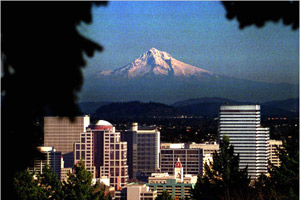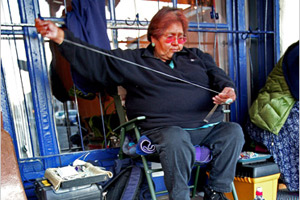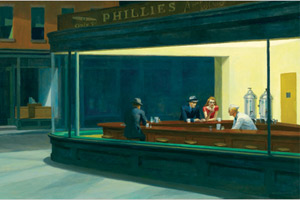Focus on America
Wealth and Hard Times Mingle in Northwest Oregon

The Oregon 1st Congressional District stretches from a vibrant metropolitan area, across densely packed suburbs and rolling farm country through the mists of forested hills before ending on one of the world’s most spectacular coastlines.
It is home to some of the state’s wealthiest and most influential citizens, and to some of its poorest.
The first part of the district to see the morning sunlight is Portland, the only substantial urban area in Oregon. The district’s slice of the city includes the state’s major banking and law offices and its largest university. This part of the city is home to the affluent residents of downtown high-rise apartments as well as the impoverished young sculptors, painters and musicians who energize Portland’s cultural life.
Just to the west, in the heavily forested West Hills, live many of the state’s wealthiest and most politically active citizens. Like most U.S. urban centers, this area long has voted a liberal and Democratic line. Its highly educated and relatively wealthy residents also form a fundraising center for the state’s Democratic Party.
To the west and south of Portland, lie the rolling suburbs of Washington County, where many residents commute each morning to downtown Portland or to the high-tech industrial parks that form the “Silicon Forest.” Washington County also boasts Oregon’s most famous corporation, the sportswear and running shoe giant Nike. Washington County is the center of the state’s spectacular population growth. In 1940, the county held 39,000 residents. Today it has half a million.
Added together, these suburbs and the slice of Portland represent less than 15 percent of the district’s size but almost three-quarters of its people. Like many suburban areas in the country, Washington County has been a solid Republican stronghold in the past, but, like those other suburbs, this area has moved toward the Democratic Party in recent years.
Grape vines frame Chateau Benoit, a winery in Yamhill County, Oregon, that has achieved a national reputation. (AP Photo/Jack Smith)To the south of Washington County’s dense suburbs lies Yamhill County, a mostly rural area, with large nut orchards, small farms and small towns such as McMinnville and Newberg.
The county also includes the newest engine of the state’s economy. On the slopes of its rolling hills, thousands of acres of orchards and forest have been cleared to make way for seemingly endless vineyards. After modest beginnings in the 1970s, Yamhill County has come to produce some of the finest wines in the United States. The income generated by wine sales represents a considerable portion of the area’s new wealth. The wineries also attract substantial income from tourists. In the last few years, small towns in the wine country have seen cinderblock taverns and sagging storefronts transformed into gourmet restaurants and trendy boutiques. Like most rural and small town areas, it generally votes Republican.
BOOMING NEW ECONOMY IN STARK CONTRAST TO DECLINING TIMBER INDUSTRY
The vineyards of Yamhill County and the high-tech parks of the Portland suburbs symbolize the state’s new economy, but the thinly populated tracts just to the west of them, stretching the length of the district, know the dark side of economic change. For more than 100 years, the dense forests of the Coastal Range typified the heart of the state’s economy. Timber was king and wood products represented the largest share of the state’s economic output.
But once-booming mill towns such as Vernonia and Scappoose are hurting as environmental concerns and changing forestry practices greatly reduce the timber harvest. This area has long been a Republican hotbed, but as Portland and the suburbs have grown, these towns have stalled and lost much of their political clout.
At the western edge of the district between the Coast Range and the beaches lies a narrow strip of land, only a few miles at its widest. The small towns stretched along the coast -- Astoria, Tillamook, Seaside -- are quiet and not particularly prosperous. In addition to the loss of timber jobs, the region’s once-thriving fishing industry has been all but wiped out.
Tourism also has suffered along the coast. But some of the beach towns have bounced back by developing high-end hotels and restaurants as well as encouraging art galleries and other tourist attractions. The coastal towns long have voted Democratic, but they are Democrats of a more conservative bent than those in the Portland area and are uneasy about their future.
Here the sun sets against the western shores of the Oregon 1st, even as it rises on the coming year’s political battles.
Recently on Focus on America
History, Culture and Science Shape Central New Mexico
 New Mexico’s 1st Congressional District is a swing district in a swing state. Situated in the geographic center of this southwest border state, the district climbs from desserts to mountains.
New Mexico’s 1st Congressional District is a swing district in a swing state. Situated in the geographic center of this southwest border state, the district climbs from desserts to mountains.
Love of Books Survives in an Electronic Age
 It probably never was the dream of Nancy Pearl, author of Book Lust, to be the model for a “shushing” librarian action figure. Yet the bespectacled Pearl is not unpleased.
It probably never was the dream of Nancy Pearl, author of Book Lust, to be the model for a “shushing” librarian action figure. Yet the bespectacled Pearl is not unpleased.
Enigmatic Images from Edward Hopper Seen in New Exhibition
 Nighthawks, the mysterious 1942 painting of four people in a diner that has become one of the best-known images of 20th-century America, is among the many striking works in a retrospective of artist Edward Hopper's work at Washington’s National Gallery of Art.
Nighthawks, the mysterious 1942 painting of four people in a diner that has become one of the best-known images of 20th-century America, is among the many striking works in a retrospective of artist Edward Hopper's work at Washington’s National Gallery of Art.